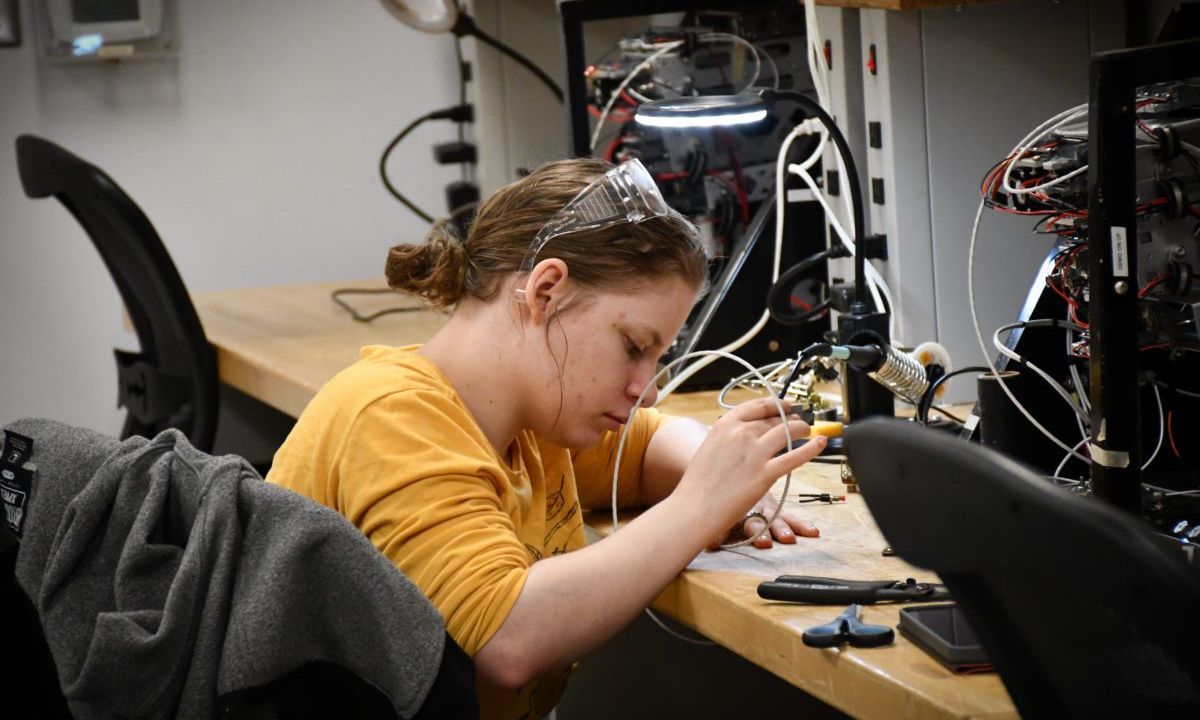Guilford County Schools Sees Increase in Dual Enrollment
From the 2021-22 school year to the 2023-24 school year, the number of students in dual enrollment classes increased by 25% in Guilford County.

Get stories like this delivered straight to your inbox. Sign up for The 74 Newsletter
Campuses are quieter now that classes are out for summer break and graduation season has come and gone. Many teachers and staffers in Guilford County Schools are looking forward to relaxing and celebrating their collective achievements, one of which being that the district has seen a large growth in dual college enrollment over the past few years.
From the 2021-22 school year to the 2023-24 school year, the number of students in dual enrollment classes increased by 25% in Guilford County, according to data from the district. Dual enrollment is a term used to describe students who are enrolled in college classes while in high school, through North Carolina’s Career and College Promise (CCP) program. Through CCP, high school students can take college level classes for free and earn credit towards a postsecondary degree, career certification, or diploma.
Earning college credits for free through CCP can save families money and help with the future cost of college tuition. It’s estimated that the credits earned by students through dual enrollment saved families more than $2 million dollars during the 2023-24 school year, according to Dr. Whitney Oakley, superintendent of Guilford County Schools.
With those college credits, many students are able to enter college with up to one year’s worth of credits completed for free. Other students may use those credits to earn an associate degree, in addition to their high school diploma, also for free.
“After they graduated, if they were actually paying tuition like at UNC-Chapel Hill, it’s $292.46 per credit hour, at GTCC it’s $76 per credit hour,” Oakley said. “We’re thinking when we add up what kids have had access to this year, it’s $2,285,472 that families in GCS say that they otherwise would be paying for if students were not still in K-12.”

Cost savings and more
The price of postsecondary education is not a new topic of discussion. People have debated the cost of college relative to the value of higher education for decades. Even so, there are always new factors to incorporate into the conversation. One timely factor is the resumption of defaulted student loans collections by the U.S. Department of Education in May 2025, which marks the first time the department has done so since before the loan repayments were paused due to the COVID-19 pandemic back in March 2020.
Dual enrollment programs like early colleges and North Carolina’s CCP program can help mitigate the overall cost of college by allowing high school students the opportunity to earn college credit for free. This is a win-win situation for both students and the workforce because it allows students to earn those credits for free and gain exposure to different workforce pathways through their classes, with the hope of helping them find their desired career earlier.
“To me it solves a much larger problem if we can get it right and aligned with workforce development needs,” Oakley said. “If more students are leaving with their associate degree, or an industry credential and going into these high-wage, high-demand careers, we as K-12 are solving this talent pipeline shortage that we’re facing across the state.”
District leadership has worked closely with Guilford Technical Community College (GTCC) to be intentional about how they market the CCP program to students, families, and schools.
“For the last couple of years, enrollment has been steadily climbing in CCP or dual enrollment,” said Wish Bailey, the assistant director of admissions and K-12 partnerships at GTCC. “And I think a large part of that is attributed to this desire for students to accumulate as many credits as they can because it looks really good when they decide to transfer, but also trying to figure out what they want to pursue when they graduate from high school.”
District and college leaders also want to make sure people understand that these CCP courses count for the same amount of credit as other college preparatory courses, like the Advanced Placement (AP) program and the International Baccalaureate (IB) program.
“The weighting is the same and the rigor is the same. It’s accepted by UNC-Chapel Hill. It’s accepted by NC State. It’s accepted by App State,” said Dr. Anthony Clarke, president of GTCC. “It’s a great savings for parents and for students to earn college credit…I think part of our growth is parents and students figuring that out and seeing that it saves them money.”
Maintaining growth
The growth that GCS and GTCC have seen in their CCP program is not accidental, leaders say. Both the school system and college have been putting a lot of effort and energy into their partnership and marketing to the greater community.
“We’ve been working really hard on the partnerships with Guilford County Schools, making sure that the counselors, as well as the parents and the students, really understand what’s being offered and making it really easy for them to enroll,” said Ann Proudfit, the vice president for student services at GTCC.
Bailey, who helps lead the implementation of K-12 partnerships for GTCC, has hosted several informational sessions about the CCP program and been intentional about reaching out to different stakeholders in the community — students, teachers, parents, counselors, and more.
“I also think the department’s outreach, by going to high schools and talking to counselors more and talking to families more about the program and the benefits of the program, (is) really just letting students know that they have this as an option,” Bailey said.
She believes that the relationships she cultivates partnered with focused outreach have resulted in more students gaining awareness of the CCP program. It’s that knowledge of possibility that has grown and continues to grow enrollment in the CCP program.
“The more that people have knowledge of the program, the more that will grow enrollment, because everyone is aware of the opportunities that are really close by,” Bailey said. “I think that’s a big part of it.”
This article first appeared on EdNC and is republished here under a Creative Commons Attribution-NoDerivatives 4.0 International License.
Get stories like these delivered straight to your inbox. Sign up for The 74 Newsletter

;)